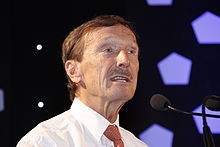Rolf M. Zinkernagel
Rolf Zinkernagel | |
|---|---|
 Zinkernagel in 2011 | |
| Born | 6 January 1944 |
| Alma mater |
|
| Known for | Cytotoxic T cells |
| Awards |
|
| Scientific career | |
| Fields | Immunology |
| Institutions | University of Zurich |
| Thesis | The role of the H-2 gene complex in cell-mediated immunity to viral and bacterial infections in mice (1975) |
| Website | www |
| Signature | |
 | |
Rolf Martin Zinkernagel AC (born 6 January 1944) is a professor of experimental immunology at the University of Zurich. Along with Peter C. Doherty, he shared the 1996 Nobel Prize in Physiology or Medicine for the discovery of how the immune system recognizes virus-infected cells.[4][5]
Education
[edit]Zinkernagel received his MD degree from the University of Basel in 1970 and his PhD from the Australian National University in 1975.[6]
Career and research
[edit]Zinkernagel is a member of the Cancer Research Institute Scientific Advisory Council,[7] the American Academy of Arts and Sciences,[8] The National Academy of Sciences,[9] the American Philosophical Society,[10] and The Academy of Cancer Immunology. Zinkernagel was elected as a Corresponding Fellow to the Australian Academy of Science also in 1996.
Awards and honours
[edit]Together with the Australian Peter C. Doherty he received the 1996 Nobel Prize in Physiology or Medicine for the discovery of how the immune system recognizes virus-infected cells. With this he became the 24th Swiss Nobel laureate. In 1999 he was awarded an honorary Companion of the Order of Australia (AC), Australia's highest civilian honour, for his scientific work with Doherty.[11]
Viruses infect host cells and reproduce inside them. Killer T-cells destroy those infected cells so that the viruses cannot reproduce. Zinkernagel and Doherty discovered that for killer T-cells to recognize infected cells, they had to recognize two molecules on the surface of the cell—not only the virus antigen, but also a molecule of the major histocompatibility complex (MHC). This recognition was done by a T-cell receptor on the surface of the T-cell. The MHC was previously identified as being responsible for the rejection of incompatible tissues during transplantation. Zinkernagel and Doherty discovered that the MHC was responsible for the body fighting meningitis viruses too.[4]
In addition to the Nobel Prize, he also won the Cloëtta Prize in 1981, the Cancer Research Institute William B. Coley Award in 1987, the Otto-Naegeli-Preis in 1988 and the Albert Lasker Medical Research Award in 1995. In 1994 he became a member of the German Academy of Sciences Leopoldina.[12] Zinkernagel was elected a Foreign Member of the Royal Society (ForMeRS) in 1998.[2][3]
References
[edit]- ^ Louis-Jeantet Prize
- ^ a b "Fellows of the Royal Society". London: Royal Society. Archived from the original on 16 March 2015.
- ^ a b "Fellowship of the Royal Society 1660-2015". Royal Society. Archived from the original on 15 October 2015.
- ^ a b Rolf M. Zinkernagel on Nobelprize.org including the Nobel Lecture December 1996 Cellular Immune Recognition and the Biological Role of Major Transplantation Antigens
- ^ Hämmerling, GJ. (January 1997). "The 1996 Nobel Prize to Rolf Zinkernagel and Peter Doherty". Cell Tissue Res. 287 (1): 1–2. doi:10.1007/s004410050726. PMID 9011383. S2CID 12529359.
- ^ Zinkernagel, Rolf (1975). The role of the H-2 gene complex in cell-mediated immunity to viral and bacterial infections in mice (PhD thesis). Australian National University.
- ^ Zinkernagel, Rolf M. "Rolf M. Zinkernagel". Cancer Research Institute. Retrieved 24 May 2023.
- ^ "Rolf Martin Zinkernagel". American Academy of Arts & Sciences. Retrieved 11 October 2021.
- ^ "Rolf M. Zinkernagel". www.nasonline.org. Retrieved 11 October 2021.
- ^ "APS Member History". search.amphilsoc.org. Retrieved 11 October 2021.
- ^ It's an Honour: AC
- ^ "Rolf M. Zinkernagel". German Academy of Sciences Leopoldina. Retrieved 1 June 2021.
External links
[edit]- Rolf M. Zinkernagel on Nobelprize.org including the Nobel Lecture December 1996 Cellular Immune Recognition and the Biological Role of Major Transplantation Antigens
- 1944 births
- Living people
- Nobel laureates in Physiology or Medicine
- Swiss Nobel laureates
- Scientists from Basel-Stadt
- Members of the European Molecular Biology Organization
- Foreign associates of the National Academy of Sciences
- Foreign members of the Royal Society
- Foreign members of the Russian Academy of Sciences
- Swiss immunologists
- Australian National University alumni
- Academic staff of the University of Zurich
- Recipients of the Pour le Mérite (civil class)
- Honorary companions of the Order of Australia
- People from Riehen
- Recipients of the Albert Lasker Award for Basic Medical Research
- Fellows of the Australian Academy of Science
- Members of the German National Academy of Sciences Leopoldina
- Members of the American Philosophical Society

